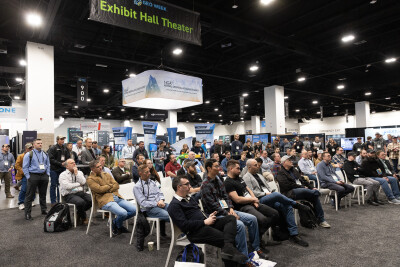MILAN, Italy – With a focus on “Virtual Systems in the Information Society,” the 18th International Conference on Virtual Systems and Multimedia wraps up here today following an ambitious, even adventurous, program of academic papers running the gamut between “A Virtual Reconstruction Approach for Archaeoastronomical Research” and “An Integrated Low-Cost System for At-Home Rehabilitation.”
Perhaps the most forward-thinking portion of the conference is an art exhibition, “No. Need. For. Real.,” based almost in entirely in augmented reality. Curated by Arthur Clay, VSMM co-chair Gabriele Guidi said the exhibition at the Triennale di Milano “is the first time with a virtual exhibit in a real museum, and this has been sponsored by VSMM.”
As with past years, there were 100 papers presented in total, but conference co-chair Lon Addison said during a Skype call there’s no question the number of people working in the fields prevalent at VSMM – historical preservation with virtual documentation; serious gaming and digital art; 3D engineering; and more – is growing.
“You can see that in the other conferences and symposia that are popping up,” Addison said. “Some of our chairs just showed up from the ISPRS conference in Melbourne and there are multiple meetings for almost every niche now.”
That’s why perhaps the biggest news to come out of VSMM 2012 is that next year’s event, in Paris, will be a co-location with a number of other conferences and gatherings in the cultural preservation space. Dates aren’t set in stone yet, but look for the event in October of 2013.
“We’re bringing together all the digital heritage conferences that we can gather,” Addison said. “We’re not sure how many yet, but it’s a rich number.” Organizations already committed are UNESCO; Computer Applications & Quantitative Methods in Archaeology (an offshoot meeting); the Virtual Museum and Technology Project; ISPRS’ 3D archaeology arm; and a number of others.
Guidi, a professor at Politecnico di Milano, noted the bringing together of the conferences could really push science forward. “It may happen that several groups send in similar papers to the same conferences, then, once one is accepted, it can’t be presented anywhere else,” he said. That limits the number of people who can hear them presented. “We have a good and prestigious venue and I think this will create a very good result.”
“There’s still work to be done, but for two years we’ve been working on the basis of bringing it all together. It’s the major international bodies in 3D, with the researchers, and we would hope the vendors,” Addison said. “We’d like to invite the vendors.”
Addison was a vendor, himself, at one point, working at the original Cyra Technologies (now part of Leica Geosystems/Hexagon) from 1998 to 2001, before coming to UNESCO.
He knows as well as anyone the significance of historic preservation to the laser scanning and data capture market as a whole. “It’s always been significant,” Addison said, “and the industry has put it in a separate category and I’m not sure why. When we were starting Cyra, where did our first system go? It was a university lab doing cultural work in Italy. Right after the first prototypes went to Chevron and the Navy, our first buyer was in heritage. It’s always been there, it’s just sometimes forgotten, or it’s an assumption, perhaps that, well, heritage isn’t as big a market as plants or engineering or BIM, but, in reality, heritage and research are very important to the community because they’re pushing the envelope.”





